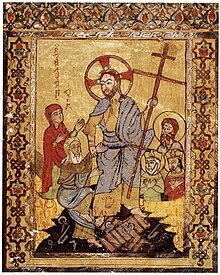This is a directory of patriarchs, archbishops, and bishops across various Christian denominations. To find an individual who was a bishop, see the most relevant article linked below or Category:Bishops.
Dionysius I Telmaharoyo, also known as Dionysius of Tel Mahre, was the Patriarch of Antioch, and head of the Syriac Orthodox Church from 818 until his death in 845.
A catholicos is the head of certain churches in some Eastern Christian traditions. The title implies autocephaly and, in some cases, it is the title of the head of an autonomous church. The word comes from ancient Greek καθολικός, derived from καθ' ὅλου from κατά and ὅλος, meaning "concerning the whole, universal, general"; it originally designated a financial or civil office in the Roman Empire.
Cyril III, known as Cyril ibn Laqlaq, was the 75th Coptic Orthodox Pope and Patriarch of Alexandria.

Alphabetical list of Eastern Christianity-related articles on English Wikipedia
Mor Baselios Paulose II was the second Maphrian of the Malankara Jacobite Syrian Orthodox Church, which is part of Syriac Orthodox Church.
The Catholicos of India, or Maphrian of the India, is the head of the Jacobite Syrian Christian Church or Malankara Jacobite Syrian Orthodox Church, a Maphrianate of the Syriac Orthodox Church in india, functioning within the Church at an ecclesiastical-rank second to the Syriac Orthodox Patriarch of Antioch, and his name is commemorated in liturgy throughout the Syriac Orthodox Archdioceses in India and its diaspora. The position was renamed as Catholicos of India in 2002, in accordance with its actual jurisdiction.
Ignatius Isaac II was the Patriarch of Antioch and head of the Syriac Orthodox Church from 1709 until his resignation in 1723.
Ignatius Noah of Lebanon, also known as Nūḥ Pūnīqoyo or Nūḥ al-Bqūfānī, was the Patriarch of Antioch and head of the Syriac Orthodox Church from 1493/1494 until his death in 1509.

Baselios Augen I was the 17th Malankara Metropolitan, the fourth Catholicos of the East in the Malankara Orthodox Syrian Church, and the first Catholicos of the East in the Malankara Syriac Orthodox Church. He was the first Catholicos consecrated in a reunified Malankara Church, by the Patriarch of Antioch in 1964 but his tenure saw a second split in the Holy Church.
Laqabin was a diocese of the Syriac Orthodox Church, suffragan of the archdiocese of Melitene. The diocese, also known as Qarna and Tella d'Arsenias, is attested between the tenth and thirteenth centuries. Twenty-three bishops of Laqabin are mentioned in the histories of Michael the Syrian and Bar Hebraeus and in other West Syriac sources. The last-known bishop of Laqabin, Timothy, was consecrated by the patriarch Philoxenus Nemrud (1283–92), and the diocese seems to have lapsed in the early decades of the fourteenth century.
John IV was the Patriarch of Antioch, and head of the Syriac Orthodox Church from 846 until his death in 873.
Athanasius IV Salhoyo was the Patriarch of Antioch and head of the Syriac Orthodox Church from 986/987 until his death in 1002/1003.
Dionysius II was the Patriarch of Antioch and head of the Syriac Orthodox Church from 896/897 until his death in 908/909.
Athanasius VI bar Khamoro was the Patriarch of Antioch, and head of the Syriac Orthodox Church from 1091 until his death in 1129.
Ignatius George II was the Patriarch of Antioch and head of the Syriac Orthodox Church from 1687 until his death in 1708.

The Syriac Orthodox Patriarch of Antioch and All the East is the Bishop of Antioch, and head of the Syriac Orthodox Church. He presides over the Holy Synod of the Syriac Orthodox Church, which is its highest authority. The current Patriarch of Antioch is Ignatius Aphrem II, who was enthroned on 29 May 2014 as the 122nd Successor to Saint Peter.

British Library, Add. 7170 is a Syriac manuscript dated to circa 1220 CE. This is one of the few highly illustrated Middle-Eastern Christian manuscripts from the 13th century. The colophon is lost, but a scribal note indicates that the manuscript was created at the time of Patriarch John and Maphrian Ignatius, who may be identified as John XII of Antioch (1208-1220) and Ignatius III David, respectively, which gives a completion date circa 1215–1220. The location where the manuscript was created is uncertain, but is generally thought to be the Jazira region near Mosul, possibly at the monastery of Deir Mar Mattai, due to artistic similarities with another manuscript securely attributed to Mosul.
The Mor Bar Sauma Monastery was a Syriac Orthodox monastery near Malatya in Turkey. The monastery served as the regular patriarchal residence from the eleventh century until the thirteenth century, and was eventually abandoned in the seventeenth century. It produced five patriarchs and forty-three metropolitan bishops. Between 1074 and 1283 several synods took place at the monastery.
Ignatius George III was the Patriarch of Antioch and head of the Syriac Orthodox Church from 1745 until his death in 1768.




